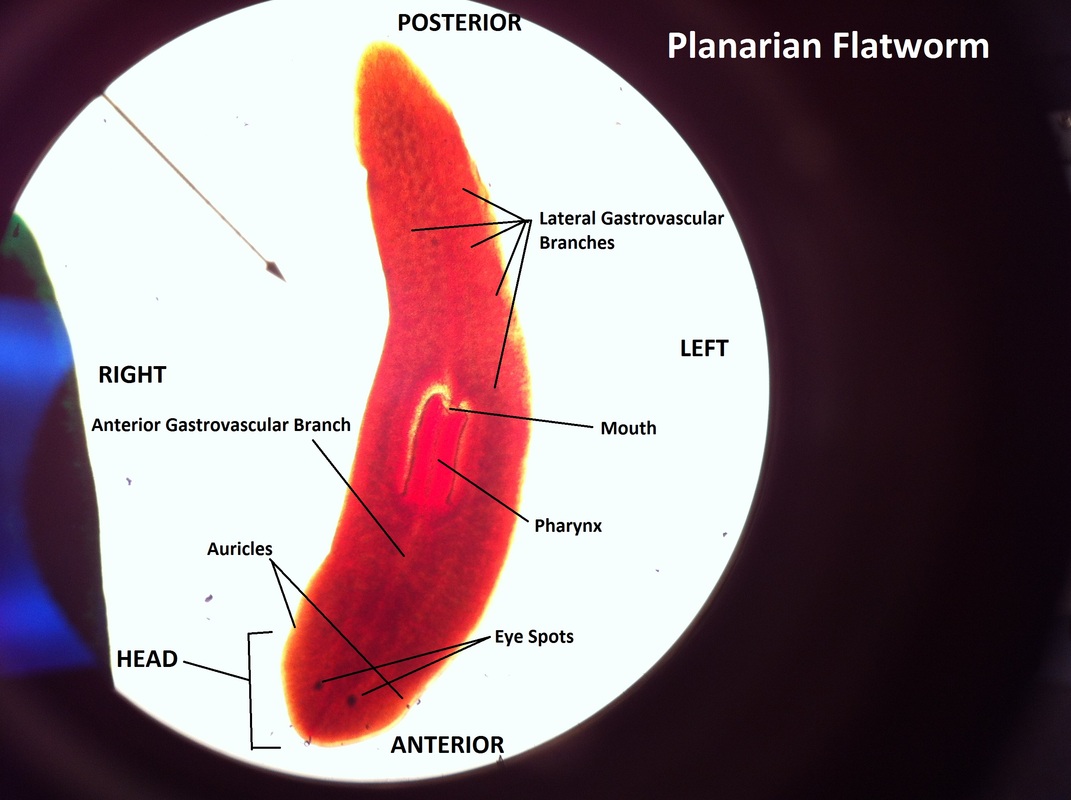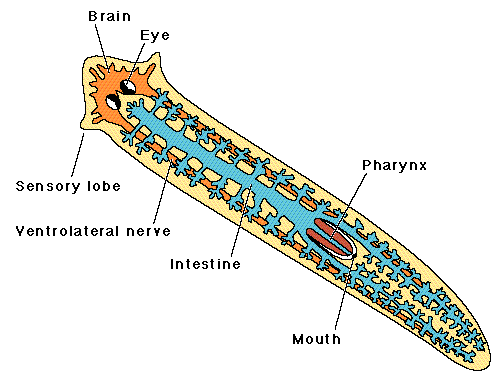Describe How the Planarian Uses Its Pharynx to Obtain Food
The body is elongated flattened and some-what conical. There are no digestive juices but large phagocytic cells that line the gastrovascular cavity pick up nutrients which then diffuse through them into other cells in the animal.

Planaria Digestive System Video Lesson Transcript Study Com
Nutrients from the food diffuse through the wall of this tract and into the animals cells.

. Observe the worm using a microscope or hand lens. When conducting this experiment again it would be best to use more sources of food to feed the planaria. If you shine a flashlight on the planarian it will attempt to move out of the light.
Use the space below to write or draw your observations. Thus planarians divide neither at a pole nor at the pharynx but have a nonzero probability of dividing anywhere else along the headtail. To observe and quantify planarian chemical-sensing behavior a tractable assay method for tracking chemotaxis behavior was developed.
By secreting mucus and moving along it using cilia and muscle contractions. Some species are parasitic. D and e pharyngeal wall.
Obtain a Dugesia and all the other materials from the front table. For this assay we used liver-extract solution the food used for culturing planarians in our laboratory as chemoattractant Figure 1A. Terms in this set 30 Describe the shape of a planarian.
Pour out some of the water so that the planarian is mostly un-submerged. Long and flat with many different sections within the body. The pharynx leads to a branched digestive tract.
The pharynx mouth of the planarian leads directly to the digestive system which is branched so that every cell of its body is close to the digestive tract. Gene-specific silencing experiments by RNA interference demonstrated that the pharyngeal nervous system. Then its nutrients diffuse to the rest of the planaria.
Of note the area of low fission probability between the peaks as determined by manual inspection of a subpopulation of n 40 specimens coincides with the location of the pharynx which is a powerful muscle used to ingest food. Describe how each of the cut halves is behaving. Planaria receive oxygen and release carbon dioxide by diffusion.
Some species are marine others are terrestrial. Body is thin and solid. The eyespots can in fact detect changes in light in the planarians environment.
Body made up of proglottids. Here we use the freshwater planarian Dugesia japonica to show that an isolated pharynx amputated from the planarian body self-directedly executes its entire sequence of feeding functions. Explain how regeneration is an adaptation for a.
Food passes from the mouth through the pharynx into the intestines where it is digested by the cells lining the intestines. Then its nutrients diffuse to the rest of the body. Most will stay close to the bottom or the edge of the dish.
Planarians are carnivores and obtain their food by predation or scavenging. In planaria the mouth and pharynx draw food particles into the animal but thats only the beginning of nutrient absorption. C pharynx anterior end facing up.
A planaria obtains food by using eyespots and special smelling cells to locate food. The tube-like pharynx is ejected from the mouth and inserted into. Obtain a new worm.
Unlike in many other organisms the intestinal luminal epithelium of flatworms consists entirely of developmentally static postmitotic differentiated cells. Lives parasitically within a host. A planarian uses its pharynx to locate food.
The mouth of planarians the pharynx is located in the middle of the planarian. Describe how planarians move throughout their aquatic habitat. The planarian digestive system is formed by a single-opening tube pharynx with extensive blind ramifications intestine.
Food sensing approach decisions about ingestion and intake. Then the planaria inserts a feeding tube and releases digestive chemicals. A hungry planarian settles above its food dying or recently dead invertebrates extends its pharynx onto the organic material and suctions fluidssoft tissuestiny organisms into its gut.
This will show not. Planarians are used in. The muscular pharynx extends through the mouth to pick up food and then withdraws into the body.
Planaria eat living or dead small animals that they suck with their muscular mouths. We reasoned that if planarian recognized the chemoattractant and showed. Planarians reproduce sexually by producing encapsulated zygotes that hatch into free-swimming larvae.
Planaria receive oxygen and release carbon dioxide by diffusion. How does it eat the food. Commonly called planaria and is a fresh water form of cosmopolitan distribution.
Observe the two pieces of the planarian under the microscope or with a hand lens. Do planarians have tissues. Planaria is the name of one genus but the name planarian is used to designate any member of the family Planariidae and related families.
Up to 24 cash back They basically eat living or dead small animals that they can catch with their mouth which is very muscular and basically helps the gastrovascular cavity to digest the food. Food passes from the mouth through the pharynx into the intestines where it is digested and its nutrients then diffuse to the rest of the body. If given a choice the planarian will actively seek an area of the dish that is dark or has some kind of cover.
Planarians respond well to food as positive reinforcement Of the trainable of species of planarians some of the successful reinforcements include. When it stretches out use a razor blade to cut it cleanly in half. Most planarians occur in fresh water and are sometimes seen in large masses.
B schematic arrangement of pharynx in the body. What type of symmetry do planarians have. Draw and describe what your regenerated planarian looks like on the 3 rd observation day.
Planaria eat living or dead small animals that they suck up with their muscular mouths. Replace the water and put the lid on it. Ie they obtain nourishment from the body of another.
A general view. Where is its mouth pharynx. Food passes from the mouth through the pharynx into the intestines where it is digested by the cells lining the intestines.
A distinct head is present which is triangular in form and bears a pair of semicircular ocelli and a pair of distinct auricles.


Comments
Post a Comment